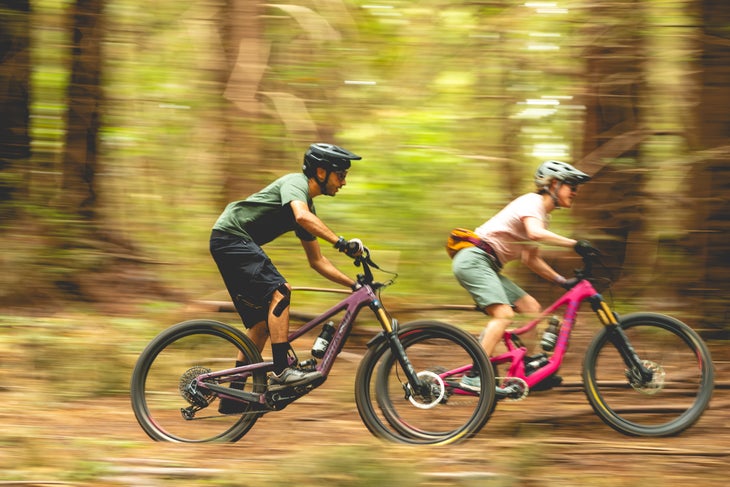You likely already know that warming up and cooling down is important to a healthy training routine, and you probably intend to do it. But it’s also likely that you find yourself squeezing rides and workouts into a busy schedule, and cutting the process short or skipping it entirely. Don’t.
Going from zero to 60 might work for a sports car, but it’s not a great idea for your body. Ramping up gradually gives your muscles time to literally warm up, making them more flexible and efficient, and allows your blood vessels to increase blood flow and oxygen delivery throughout your body. This is key for keeping soreness at bay and can help prevent injuries. Cooling down is equally important, as this keeps your blood pressure and heart rate from nosediving too quickly.
Use the expert tips below to make warming up and cooling down an effective part of your training routine. And give yourself an advantage with KT’s magnesium creams and kinesiology tape that are purpose-made for the job. As a lifelong athlete, Ryan Van Duzer knows the value of caring for his body, which is why he uses KT Health Activate Magnesium Cream to warm up, and KT Tape Pro Ice to support his muscles and reduce soreness. And as cyclist Dustin Klein shows, KT Tape Pro Ice beats strapping on ice packs. By a lot.
Here’s how to incorporate smart warm-up and cool-down strategies into your workout.
- Kick off your workout with five to ten minutes of slow jogging or cycling. The longer your routine, the more time you should spend warming up.
- “Don’t stretch cold,” advises Dr. Hassler, an athletic trainer and member of KT’s Sports Medicine Advisory Board. “First give yourself a warmup and make sure you’re getting a good range of motion at all major joints.” Stretching a tight muscle before the warm-up can actually cause injury.
- Try adding KT Health Activate Magnesium Cream to your warm-up routine. Made with arnica, aloe, vitamin E, and shea butter, this cream helps reduce muscle stiffness and relieves soreness as you get moving.
- At the end of your workout, spend another five to ten minutes cooling down by walking or slowly jogging or cycling. Stretch again to further prevent muscle soreness. Rubbing on KT Health Recover Magnesium Cream provides cooling pain relief for muscles and joints after your big push.
Shop KT Health Activate Magnesium Cream
3 Key Flexibility Moves
Add these tailored stretches to your pre- and post-workout routines.
Cat Cows
Spine extensions are excellent for loosening up back muscles and protecting mobility. Cyclists benefit from this one because they spend so much time in a forward riding position, but it also helps runners fend off lower back pain. “Keep your spine moving, and you’ll feel a lot better,” says Dr. Kyle Richmond, a sports chiropractor and KT Tape ambassador. Get on your hands and knees with your wrists stacked under your shoulders and your knees under your hips. Curve your back and pelvis while looking up (the “cow” pose), then slowly arch your back and drop your head and pelvis (the “cat” pose). Slowly move through the sequence a few more times.
Leg Swings
Dynamic stretches—that is, stretches that involve movement rather than holding a position—add a new dimension to your flexibility work. These leg swings recruit a variety of leg muscles as well as the hip flexors. Stand next to a wall (or tree) and swing one leg forward and backward. Start with smaller movements and progress up to wider swings, completing ten full swings. Then swing the same leg side to the side ten times. Switch legs and repeat.

Standing IT Band Stretch
“A lot of times, people will focus on only stretching things in the front or back,” Dr. Hassler says. “But you have to take care of the lateral side.” The iliotibial (IT) band, which runs from the hip down the outside of the thigh, is especially prone to getting tight or inflamed in runners and cyclists because of the repetitive motion in their sports. Take care of it with this simple stretch: Stand near a wall or chair and cross your right foot in front of your left foot at the ankle. Extend your left arm overhead and reach it over to the right, stretching along the side of your left leg. Hold for about 30 seconds, then switch legs.
Since 2008, KT has been revolutionizing the sports medicine industry with the most technologically advanced and recognized kinesiology tape and recovery products. KT Tape kinesiology tape provides localized increase in blood flow to relieve pain and provide support for muscle pain and common injuries. And now, KT has introduced a line of KT Health products to include topical pain relief, diabetes care, ice/heat treatment, footcare, and more. The purpose of KT is to provide solutions that empower movement to unleash every body’s potential for everyone from everyday athletes to the pros.